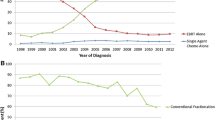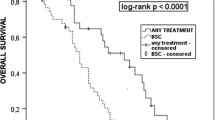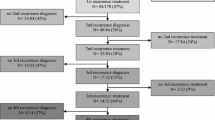Abstract
We investigated the influence of various clinical prognostic factors in patients with glioblastoma multiforme (GBM) treated with a combined modality approach. A total of 175 patients with GBM was treated in four consecutive prospective phase II studies using surgery, hyperfractionted or accelerated hyperfractionated radiotherapy (RT) and either adjuvant or concurrent or pre-irradiation chemotherapy (CHT) between Janaury 1988 and December 1993. The median survival time for all 175 patients was 14 months and 1–3-year survival (OS) rates were 57%, 34% and 24%, respectively. The median time to tumour progression was 12 months, and 1–3-year progression-free survival (PFS) rates were 43%, 11% and 7%, respectively. Survival analysis showed that of all investigated prognostic factors, only gender did not influence survival. Patients ≤55 years did better than those >55 years; patients with KPS 80–100 did better than those with KPS 50–70; patients with frontal tumours did better than those with tumours in other locations; patients with tumours up to 4 cm did better than those with larger tumours, as did patients with either subtotal or gross total tumour resection when compared to those undergoing biopsy only. Multivariate analysis showed that gender and tumour location did not independently influence survival. When PFS was used as the endpoint, only gender did not influence PFS, as confirmed by multivariate analysis.





Similar content being viewed by others
References
Deutch M, Green SB, Strike TA, et al (1989) Results of randomized trial comparing BCNU plus radiotherapy, streptozocin plus radiotherapy, BCNU plus hyperfractionated radiotherapy, and BCNU following misonidasole plus radiotherapy in the post-operative treatment of malignant glioma. Int J Radiat Oncol Biol Phys 16:1389–1396
Kristiansen K, Hagen S, Kollevold T, et al (1981) Combined modality therapy of operated astrocytomas Grade III and IV. Confirmation of the value of postoperative irradiation and lack of potentiation of bleomycin on survival time: a prospective multicenter trial of the Scandinavian Glioblastoma Study group. Cancer 47:649–652
Nelson DF, Diener-West M, Weinstein AS, et al (1986) A randomized comparison of misonidasole sensitized radiotherapy plus BCNU and radiotherapy plus BCNU for treatment of malignant glioma after surgery: final report of an RTOG study. Int J Radiat Oncol Biol Phys 12:1793–1800
Salazar OM, Rubin P, Feldstein ML, Pizzutiello R (1979) High dose radiation therapy in the treatment of malignant gliomas: final report. Int J Radiat Oncol Biol Phys 5:1733–1740
Kolker JD, Halpern HJ, Krishnasamy S, et al (1990) "Instant-mix" whole brain photon with neutron boost radiotherapy for malignant gliomas. Int J Radiat Oncol Biol Phys 19:409–414
Jeremic B, Jovanovic D, Djuric L, Jevremovic S, Mijatovic L (1992) Advantage of post-radiotherapy chemotherapy with CCNU, procarbazine and vincristine (mPCV) over chemotherapy with VM-26 and CCNU. J Chemother 4:123–126
Levin VA, Silver P, Hannigan J, et al (1980) Superiority of post-radiotherapy adjuvant chemotherapy with CCNU, procarbazine and vincristine (PCV) over BCNU for anaplastic astrocytoma: NCOG 6G91 final report. Int J Radiat Oncol Biol Phys 18:321–324
Jeremic B, Grujicic D, Antunovic V, Djuric Lj, Stojanovic M, Shibamoto Y (1994) Hyperfractionated radiation therapy (HFX RT) followed by multiagent chemotherapy (CHT) in patients with malignant glioma: a phase II study. Int J Radiat Oncol Biol Phys 30:1179–1185
Jeremic B, Grujicic D, Antunovic V, Djuric Lj, Shibamoto Y (1995) Accelerated hyperfractionated radiation therapy for malignant glioma. A phase II study. Am J Clin Oncol (CCT) 18:449–453
Nelson DF, Curran WJ Jr, Scott CB, et al (1993) Hyperfractionated radiation therapy and bis-chlorethyl nitrosourea in the treatment of malignant glioma: possible advantage observed at 72.0 Gy in 1.2 Gy b.i.d. fractions: report of the Radiation Therapy Oncology Group protocol 8302. Int J Radiat Oncol Biol Phys 25:193–207
Sneed PK, Gutin PH, Larson DA, et al (1994) Patterns of recurrence of glioblastoma multiforme after external irradiation followed by implant boost. Int J Radiat Oncol Biol Phys 29:719–727
Mehta MP, Masciopinto J, Rozental J, et al (1994) Stereotactic radiosurgery for glioblastoma multiforme: report of a prospective study evaluating prognostic factors and analyzing long-term survival advantage. Int J Radiat Oncol Biol Phys 30:541–549
Shrieve DC, Alexander E 3rd, Black PM, Wen PY, Fine HA, Kooy HM, Loeffler JS (1994) Treatment of patients with primary glioblastoma multiforme with standard postoperative radiotherapy and radiosurgical boost: prognostic factors and long-term outcome. J Neurosurg 90:72–77
Regine WF, Patchell RA, Strottmann JM, Meigooni A, Sanders M, Young AB (2000) Preliminary report of a phase I study of combined fractionated stereotactic radiosurgery and conventional external beam radiation therapy for unfavourable gliomas. Int J Radiat Oncol Biol Phys 48:421–426
Cardinale RM, Schmidt-Ullrich RK, Benedict SH, Zwicker RD, Han DC, Broaddus WC (1998) Accelerated radiotherapy regimens for malignant gliomas using stereotactic concomitant boosts for dose escalation. Radiat Oncol Investigat:175–181
Shiu A, Kooy H, Ewton J (1997) Comparison of miniature multileaf collimation (MMLC) with circular collimation for stereotactic treatment. Int J Radiat Oncol Biol Phys 37:679–688
Khoo VS, Oldham M, Adams EJ, Bedford JL, Webb S, Brada M (1999) Comparison of intensity-modulated tomotherapy with stereotactically guided conformal radiotherapy for brain tumors. Int J Radiat Oncol Biol Phys 45:415–425
Woo SY, Granbt III WH, Belleza D (1996) A comparison of intensity modulated conformal therapy with aconventional external beam stereotactic radiosurgery system for the treatment of single and multiple intracranial lesions. Int J Radiat Oncol Biol Phys 35:593–597
Pirzkall A, McKnight TR, Graves EE et al (2001) MR-spectroscopy guided target delineation for high-grade gliomas. Int J Radiat Oncol Biol Phys 50:915–928
Biersack HJ, Coenen HH, Stocklin G, Reichmann K, Bockisch A, Oehr P, Kashab M, Rollmann (1989) Imaging of brain tumors with L-3-(123I)iodo-alpha-methyl-L-tirosine. J Nucl Med 30:110–112
Weber W, Bartenstein P, Gross MW, Kinzel D, Daschner D, Feldmann HJ, Reidel G, Ziegler SI, Lumenta C, Molls M, Schwaiger M (1997) Fluorine-18-FDG PET and iodine-123-IMT SPECT in the evaluation of brain tumors. J Nucl Med 38:802–808
Gross MW, Weber W, Feldmann HJ, Bartenstein P, Schwaiger M, Molls M (1998) The value of F-18-fluorodeoxyglucose PET for the 3-D radiation treatmnt planning of malignant gliomas. Int J Radiat Oncol Biol Phys 41:989–995
Grosu A-L, Weber W, Feldmann HJ, Wuttke B, Bartenstein P, Gross MW, Lumenta C, Schwaiger M, Molls M (2000) First experience with I-123-alpha-methyl-tyrosine SPECT in the 3-D radiation treatment planning of brain gliomas. Int J Radiat Oncol Biol Phys 47:517–526
Grosu A-L, Feldmann HJ, Dick S, Dzewas B, Nieder C, Gumprecht H, Frank A, Schwaiger M, Molls M, Weber WA (2002) Implications of IMT-SPECT for postoperative radiotherapy planning in patients with gliomas. Int J Radiat Oncol Biol Phys 54:842–854
Glatstein E, Makuch RW (1984) Illusion and reality: practical pitfalls in interpreting clinical trials. J Clin Oncol 2:488–497
Simon R (1984) Importance of prognostic factors in cancer clinical trials. Cancer Treat Rep 68:185–192
Curran WJ Jr, Scott CB, Horton J, et al (1993) Recursive partitioning analysis of prognostic factors in three Radiation Therapy Oncology Group malignant glioma trials. J Natl Cancer Inst 85:704–710
Jeremic B, Shibamoto Y, Grujicic D, et al (1999) Preirradiation carboplatin and etoposide and accelerated hyperfractionated radiation therapy in patients with high-grade astrocytomas. A phase II study. Radiother Oncol 51:27–33
Jeremic B, Shibamoto Y, Grujicic D, et al (2001) Concurrent accelerated hyperfractionated radiation therapy and carboplatin/etoposide in patients with malignant glioma: long-term results of a phase II study. J Neuro-Oncol 51:133–141
Hulshof MCCM, Schimmel EC, Bosch AD, Gonzalez DG (2000) Hypofractionation in glioblastoma multiforme. Radiother Oncol 54:143–148
Simpson JR, Horton J, Scott C, et al (1993) Influence of location and extent of surgical resection on survival of patients with glioblastoma multiforme: results of three consecutive Radiation Therapy Oncology Group (RTOG) clinical trials. Int J Radiat Oncol Biol Phys 26:239–244
Kreth FW, Warnke PC, Scheremet R, Ostertag CB (1993) Surgical resection and radiation therapy in the treatment of glioblastoma multiforme. J Neurosurg 78:762–766
Kreth FW, Berlis A, Spiropoulou V, et al (1999) The role of tumor resection in the treatment of glioblastoma multiforme in adults. Cancer 86:2117–2123
Lacroix M, Abi-Said D, Fourney DR, et al (2001) A multivariate analysis of 416 patients with glioblastoma multiforme. J Neurosurg 95:190–198
Shinoda J, Sakai N, Murase S, Yano H, Matsuhisa T, Funakoshi T (2001) Selection of eligible patients with supratentorial glioblastoma multiforme for gross total resection. J Neurooncol 52:161–171
Gamburg ES, Regine WF, Patchell RA, Strotmann JM, Mohiuddin M, Young AB (2000) The prognostic significance of midline shift at presentation on survival in patients with glioblastoma multiforme. Int J Radiat Oncol Biol Phys 48:1359–1362
Jeremic B, Grujicic D, Antunovic V, Stojanovic M, Shibamoto Y (1994) Influence of the extent of surgery and tumor location on treatment outcome of patients with glioblastoma multiforme treated with combined modality approach. J Neurooncol 21:177–185
Jelsma R, Bucy PC (1967) The treatment of glioblastoma multiforme of the brain. J Neurosurg 27:388–400
Jelsma R, Bucy PC (1969) Glioblastoma multiforme. Its treatment and some factors effecting survival. Arch Neurol 20:161–171
Kinsella TJ, Rowland CJ, Klecker R et al (1988) Pharmacology and phase I/II study of continuous intravenous infusions of iododeoxyuridine and hyperfractionated radiotherapy in patients with glioblastoma multiforme. J Clin Oncol 6:876–879
Newall J, Ranshoff J, Kaplan B (1988) Glioblastoma in the older patient: how long a course of radiotherapy is necessary? J Neurooncol 6:325–327
Salcman M (1985) Resection and reoperation in neuro-oncology. Rationale and approach. Neurol Clin 3:831–842
Salcman M (1987) Surgical decision-making for malignant brain tumors. Clin Neurosurg 35:285–313
Davis L, Martin J, Goldstein SL et al (1949) A study of 211 patients with verified glioblastoma multiforme. J Neurosurg 6:33–44
Andreou J, George AE, Wise A et al (1983) CT prognostic criteria of survival after malignant glioma surgery. AJNR 4:488–490
Hoshino T (1984) A commentary on the biology and growth kinetics of low-grade and high-grade gliomas. J Neurosurg 61:895–900
Cushing H (1932) Intracranial tumors. Notes upon a series of 2,000 verified cases with surgical mortality percentages pertaining thereto. Thomas, Springfield
Chang CH, Horton J, Schoenfeld D, et al (1983) Comparison of postoperative radiotherapy and combined postoperative radiotherapy and chemotherapy in the multidisciplinary management of malignant gliomas. Cancer 52:997–1007
Walker MD, Alexander E, Hunt WE, Mahaley MS, Ranshoff J, Gehan EA (1978) Evaluation of BCNU and/or radiotherapy in the treatment of anaplastic gliomas. J Neurosurg 49:333–343
Quigley MR, Maroon JC (1991) The relationship between survival and the extent of resection in patients with supratentorial malignant gliomas. Neurosurgery 29:385–389
Nazzaro JM, Neuwelt EA (1990) The role of surgery in the management of supratentorial intermediate and high-grade astrocytomas in adults. J Neurosurg 73:331–334
Devaux BC, O'Fallon JR, Kelly PJ (1993) Resection, biopsy, and survival in malignant glial neoplasms. J Neurosurg 78:767–775
Kowalczuk A, Macdonald RL, Amidei C, et al (1997) Quantitative imaging study of extent of surgical resection and prognosis of malignant astrocytomas. Neurosurgery 41:1028–1038
Albert FK, Forsting M, Sartor K, Adams H-P, Kunze S (1994) Early postoperative magnetic resonance imaging after resection of malignant glioma: objective evaluation of residual tumor and its influence on regrowth and prognosis. Neurosurgery 34:45–61
Coffey RJ, Lunsford LD, Taylor FH (1988) Survival after stereotactic biopsy of malignant gliomas. Neurosurgery 22:465–473
Wood JR, Green SB, Shapiro WR (1988) The prognostic importance of tumor size in malignant gliomas: a computed tomography scan study by the Brain Tumor Cooperative Group. J Clin Oncol 6:338–343
Hitchcock E, Sato F (1964) Treatment of malignant gliomata. J Neurosurg 21:497–505
Wurschmidt F, Buenemann H, Heilmann H-P (1995) Prognostic factors in high-grade malignant glioma. A multivariate analysis of 76 cases with postoperative radiotherapy. Strahlenther Onkol 171:315–321
Hoshino T, Wilson CB, Rosenblum ML, et al (1975) Chemotherapeutic implications of growth and cell cycle time in glioblastomas. J Neurosurg 43:127–135
Onoyama Y, Abe M, Yabumoto E, et al (1976) Radiation therapy in the treatment of glioblastoma. Am J Roentgenol 126:481–492
Ramsay RG, Brand WN (1973) Radiotherapy of glioblastoma multiforme. J Neurosurg 39:197–202
Burger PC, Green SB (1987) Patient age, histologic features, and length of survival in patients with glioblastoma multiforme. Cancer 59:1617–1625
Hoshino T, Prados M, Wilson CB, et al (1989) Prognostic significance of the bromodeoxyuridine labeling index of human gliomas. J Neurosurg 71:335–341
Author information
Authors and Affiliations
Corresponding author
Rights and permissions
About this article
Cite this article
Jeremic, B., Milicic, B., Grujicic, D. et al. Multivariate analysis of clinical prognostic factors in patients with glioblastoma multiforme treated with a combined modality approach. J Cancer Res Clin Oncol 129, 477–484 (2003). https://doi.org/10.1007/s00432-003-0471-5
Received:
Accepted:
Published:
Issue Date:
DOI: https://doi.org/10.1007/s00432-003-0471-5




